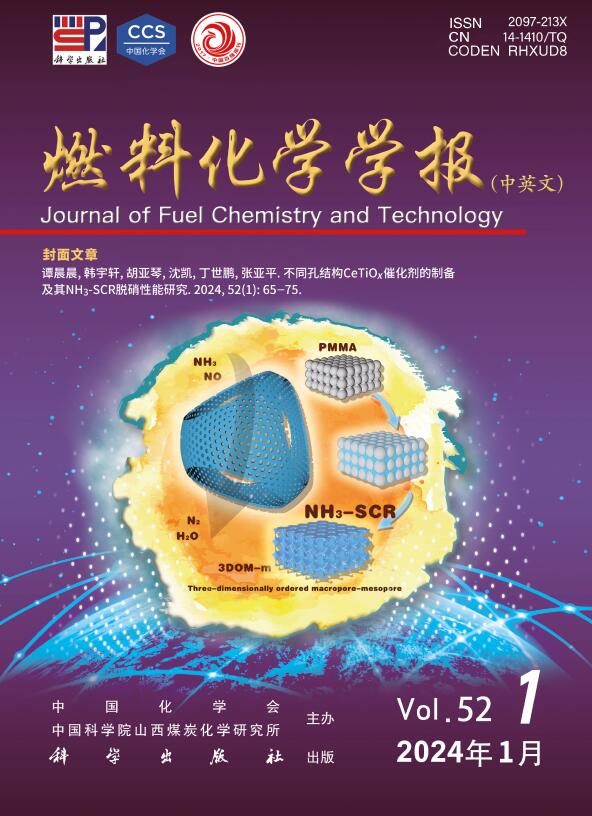调节FeMoOx/LaTiOy的Fe/Mo比促进柴油好氧氧化脱硫
Q3 Energy
引用次数: 0
摘要
催化氧化脱硫(CODS)技术以其成本低、反应条件温和、脱硫性能优越等优点,在柴油脱硫领域具有广阔的应用前景。本文采用柠檬酸辅助法制备了一系列不同Fe/Mo比的FeMoOx/LaTiOy-z样品。采用TEM、BET、UV-vis DRS、XPS、XANES和反应动力学等手段,系统表征了Fe掺入对合成的FeMoOx/LaTiOy-z催化剂的Mo分散态、表面元素态和氧含量的影响,并考察了其去除4,6- dmdbt的CODS性能。实验结果表明,Fe/Mo比对FeMoOx/LaTiOy-z催化剂上的Ti−O键强度、Mo的表面分散和电子结构有显著影响。FeMoOx/LaTiOy-2催化剂具有良好的MoO3分散性、最佳的氧化还原性能和最高的氧空位浓度,在75 min内可100%去除模型油中的4,6- dmdbt,具有出色的循环耐久性和最佳的CODS性能。然而,Fe含量的进一步增加导致Mo的分散性增加,而活性Mo的减少以及4,6- dmdbt进入催化活性位点的位阻效应的增加,使FeMoOx/LaTiOy-z (z> 2)催化剂在CODS过程中的表观活化能显著增加,从而严重抑制了其CODS性能。此外,自由基捕获实验表明,活性位点O2活化产生的·将4,6- dmdbt催化氧化为4,6- dmdbto2的产物,从而实现了深度脱硫和高值4,6- dmdbto2的回收。这些发现为实现超深度脱硫以及从柴油中分离和回收高经济价值的砜类物质提供了一种替代策略。本文章由计算机程序翻译,如有差异,请以英文原文为准。
Regulating the Fe/Mo ratio of FeMoOx/LaTiOy to boost aerobic oxidative desulfurization of diesel
Catalytic oxidation desulfurization (CODS) technology has shown great promise for diesel desulfurization by virtue of its low cost, mild reaction conditions, and superior desulfurization performance. Herein, a series of FeMoOx/LaTiOy-z samples with diverse Fe/Mo ratios were prepared via a facile citric acid-assisted method. The impact of Fe incorporation on the dispersion and surface elemental states of Mo species, as well as oxygen species content of the synthesized FeMoOx/LaTiOy-z catalysts were systematically characterized using TEM, BET, UV-vis DRS, XPS, XANES, and reaction kinetics, and their CODS performances were examined for 4,6-DMDBT removal. Experimental results demonstrated that Fe/Mo ratio significantly affected the Ti−O bond strength, surface dispersion and electronic structure of Mo species on FeMoOx/LaTiOy-z catalysts. FeMoOx/LaTiOy-2 catalyst showed outstanding cycling durability and the best CODS performance with almost 100% removal of 4,6-DMDBT from model oil within 75 min due to its proper MoO3 dispersion, optimal redox property, and the most oxygen vacancy concentration. Nevertheless, further enhancing Fe content led to the increased dispersion of Mo species, while the decrease active Mo species as well as the increase of steric effect for 4,6-DMDBT accessing to the catalytic reactive sites considerably increase the apparent activation energy of FeMoOx/LaTiOy-z (z> 2) catalysts during the CODS process, thereby seriously suppressing their CODS performances. Moreover, Radical trapping experiments reveal that the ·, generated by the activation of O2 at the active sites, catalytic oxidized 4,6-DMDBT to the product of 4,6-DMDBTO2, thereby enabling both deep desulfurization and recovery of high-value 4,6-DMDBTO2. These findings offer an alternative strategy to achieve ultra deep desulfurization as well as separate and recover high economic value sulfone substances from diesel.
求助全文
通过发布文献求助,成功后即可免费获取论文全文。
去求助
来源期刊

燃料化学学报
Chemical Engineering-Chemical Engineering (all)
CiteScore
2.80
自引率
0.00%
发文量
5825
期刊介绍:
Journal of Fuel Chemistry and Technology (Ranliao Huaxue Xuebao) is a Chinese Academy of Sciences(CAS) journal started in 1956, sponsored by the Chinese Chemical Society and the Institute of Coal Chemistry, Chinese Academy of Sciences(CAS). The journal is published bimonthly by Science Press in China and widely distributed in about 20 countries. Journal of Fuel Chemistry and Technology publishes reports of both basic and applied research in the chemistry and chemical engineering of many energy sources, including that involved in the nature, processing and utilization of coal, petroleum, oil shale, natural gas, biomass and synfuels, as well as related subjects of increasing interest such as C1 chemistry, pollutions control and new catalytic materials. Types of publications include original research articles, short communications, research notes and reviews. Both domestic and international contributors are welcome. Manuscripts written in Chinese or English will be accepted. Additional English titles, abstracts and key words should be included in Chinese manuscripts. All manuscripts are subject to critical review by the editorial committee, which is composed of about 10 foreign and 50 Chinese experts in fuel science. Journal of Fuel Chemistry and Technology has been a source of primary research work in fuel chemistry as a Chinese core scientific periodical.
 求助内容:
求助内容: 应助结果提醒方式:
应助结果提醒方式:


